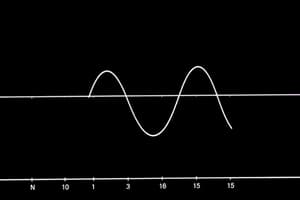Podcast
Questions and Answers
What is the characteristic of the catalyst in surface adsorption theory?
What is the characteristic of the catalyst in surface adsorption theory?
- It can be either a solid, liquid, or gas
- It is always a gas
- It is always a liquid
- It is always a solid (correct)
What is the effect of an increase in temperature of 10K on the number of collisions?
What is the effect of an increase in temperature of 10K on the number of collisions?
- A small increase of 50% (correct)
- A significant increase of 100%
- No change
- A decrease of 20%
What is the effect of catalytic poisons on the reaction rate?
What is the effect of catalytic poisons on the reaction rate?
- They increase the reaction rate by blocking inactive sites
- They increase the reaction rate by increasing the activation energy
- They have no effect on the reaction rate
- They decrease the reaction rate by blocking active sites (correct)
What is the relationship between concentration and rate of reaction?
What is the relationship between concentration and rate of reaction?
What is the graphical method to determine the instantaneous rate of reaction?
What is the graphical method to determine the instantaneous rate of reaction?
What is the characteristic of the reaction if ∆H is negative?
What is the characteristic of the reaction if ∆H is negative?
What is the effect of increasing the surface area of the catalyst?
What is the effect of increasing the surface area of the catalyst?
What is the term used to describe the accumulation of one substance at the surface of another?
What is the term used to describe the accumulation of one substance at the surface of another?
What is the primary function of manganese dioxide in the decomposition of hydrogen peroxide?
What is the primary function of manganese dioxide in the decomposition of hydrogen peroxide?
What is the term for the minimum energy required for colliding particles to result in a reaction?
What is the term for the minimum energy required for colliding particles to result in a reaction?
Which of the following is an example of heterogeneous catalysis?
Which of the following is an example of heterogeneous catalysis?
What is the rate of reaction measured in terms of?
What is the rate of reaction measured in terms of?
What is the term for a product of a reaction that becomes a catalyst for the same reaction?
What is the term for a product of a reaction that becomes a catalyst for the same reaction?
Which of the following is NOT a factor affecting the rate of reaction?
Which of the following is NOT a factor affecting the rate of reaction?
What is the term for the theory that involves homogeneous catalysis?
What is the term for the theory that involves homogeneous catalysis?
What is the definition of a catalyst?
What is the definition of a catalyst?
What is the term for a collision that results in a reaction?
What is the term for a collision that results in a reaction?
Flashcards are hidden until you start studying




